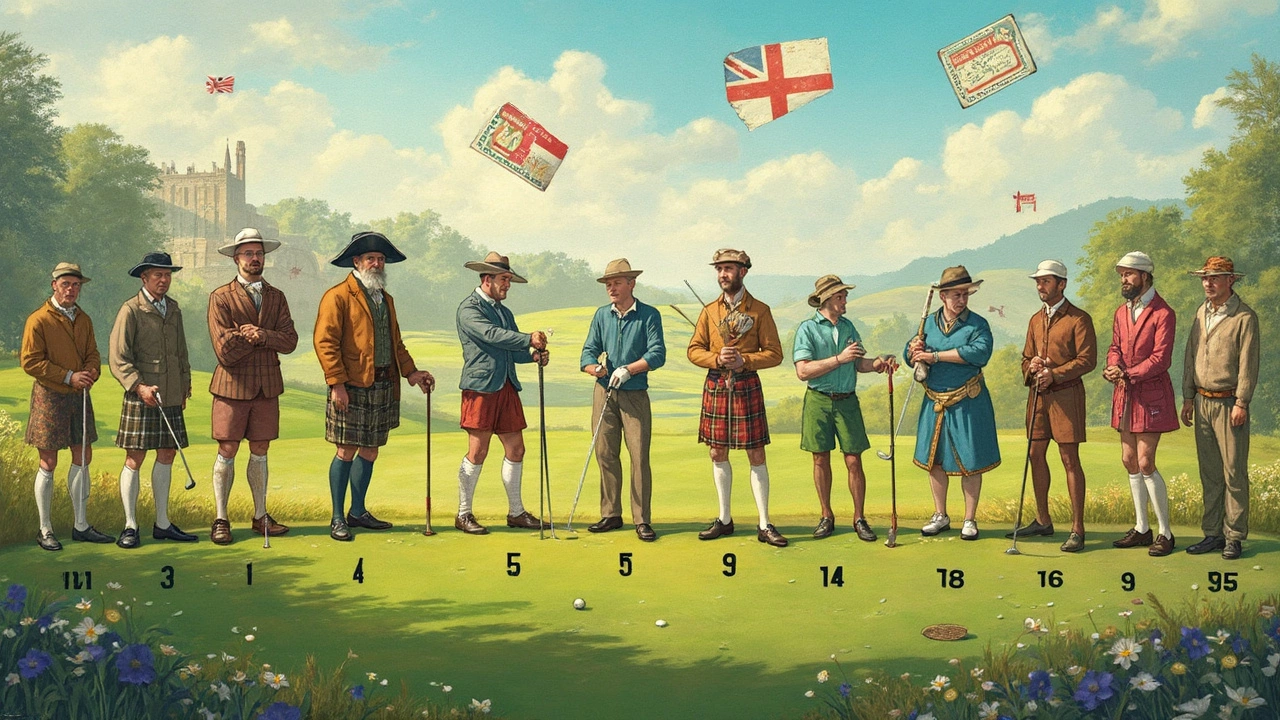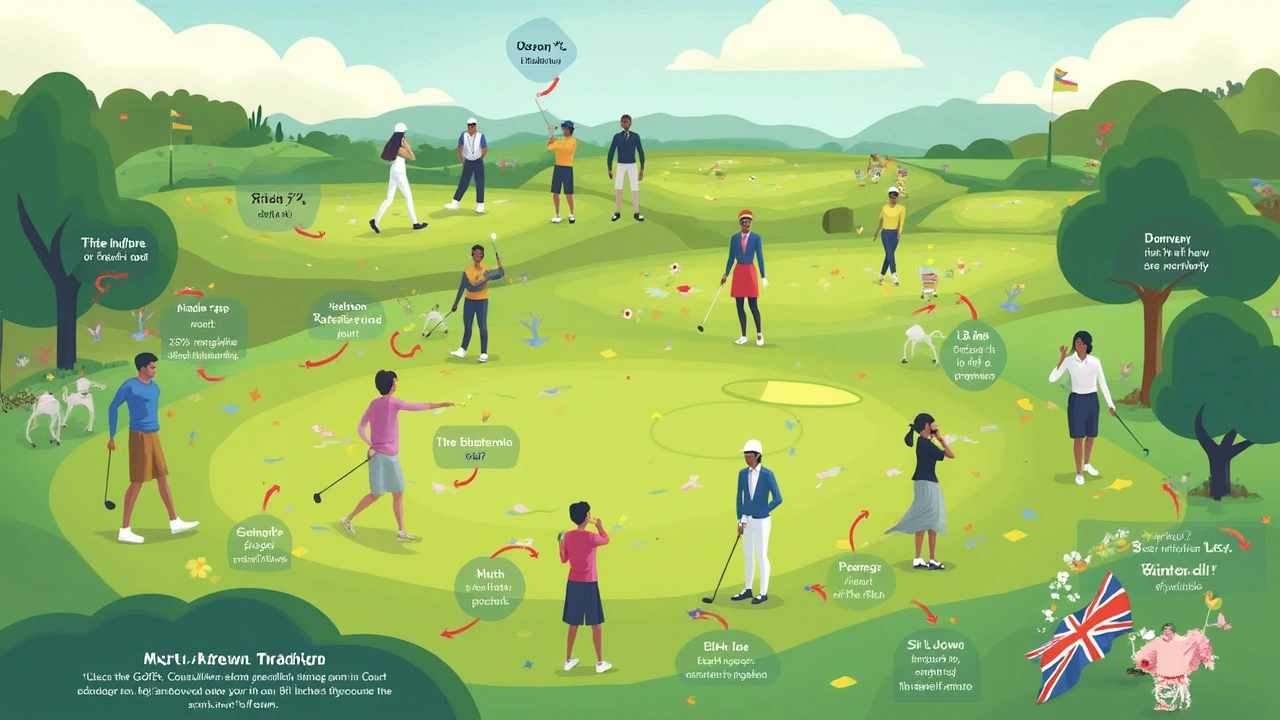
Golfers get used to the number 18 pretty quick, but not many actually stop and wonder, “Why isn’t it 16? Or 12?” The magic number didn’t just pop out of thin air, and it’s not because it matches some ancient code or riddle. There’s real history behind it—and it’s not as complicated as you might guess.
If you’ve ever dragged your clubs around a massive course, you know 18 holes feels like the perfect balance. You’re tired, but not totally wiped out. There’s a reason for that sweet spot. Turns out, the answer started way back in Scotland, where golf had more to do with sheep and sand dunes than any fancy planning. The way those first courses used the land sort of forced things into shape, and what the early golfers settled on stuck—or at least, it stuck well enough to become the gold standard.
- The Quirky Origins of 18 Holes
- How the Old Course Shaped the Game
- Busting the Whiskey Bottle Myth
- Modern Courses and Their Variations
- Tips for Enjoying a Full Round
The Quirky Origins of 18 Holes
Believe it or not, golf wasn’t always played on 18 holes. Back in the 1700s, there was no set rule—courses could have 7, 12, even 22 holes. The real turning point comes from the Old Course at St Andrews in Scotland. Originally, it had 22 holes. Golfers would play 11 out, then the same 11 back in. Simple, right? Well, in 1764, the St Andrews folks realized some holes were way too short, so they combined a few, cutting the total number down to 18. This new layout was just supposed to be more practical for their land, not some big statement for all of golf.
But here’s where things get interesting. St Andrews had a reputation and everyone else wanted to copy it. Courses across the country started trimming or adding holes to match. By the late 1800s, the golf world pretty much settled on 18 holes as the standard—simply because that’s what the most famous course was doing. No magic, just good old copycat behavior.
To put it in perspective, take a look at these early golf course setups:
| Course | Year | Original Holes |
|---|---|---|
| St Andrews | 1552 (original) | 22 |
| Musselburgh Links | 1672 | 7 |
| Royal Aberdeen | 1780 | 17 |
If you’re thinking it sounds a bit random, that’s kind of the point. There was no master plan. People just followed a good idea when they saw it working. The golf world agreed—18 was just right, not too long, not too short. And that’s how it stuck.
How the Old Course Shaped the Game
If you trace the story behind 18 holes, St Andrews is the place you land every time. The Old Course at St Andrews in Scotland is known as the real birthplace of golf’s layout—and the rules.
Here’s the deal: Back in the early 1700s, the Old Course had 22 holes. People would play 11 out, turn around, and play the same 11 holes back in. But by 1764, the St Andrews crew got tired of some of the shorter holes, so they combined a few. That cut the total number down to 18. Other courses saw this change and thought, 'Hey, that works.' Before long, everyone was following what St Andrews started. This wasn’t some big boardroom decision. Regular folks just liked the flow and balance, and it caught on.
Why did it matter? St Andrews had big influence. Their local choices shaped the direction for courses across the world, especially after golfers started writing down and sharing their rules. Since then, golf has stuck to the 18 hole format as the proper way to play the game from start to finish.
Some quick highlights about how the Old Course shaped things:
- First place to use the 18-hole layout, back in 1764.
- Same stretch of fairways were used for both outward and inward play, but each direction felt different.
- Other courses and clubs basically copied the Old Course's setup—the tradition just spread from there.
If you’re into numbers, check out this simple table about how the Old Course’s layout changed things:
| Year | Total Holes | Reason for Change |
|---|---|---|
| Early 1700s | 22 | Original layout – 11 holes played twice |
| 1764 | 18 | Combined shorter holes to make the game flow better |
So, when you walk out onto an 18-hole course, you’re really following the footsteps of people at St Andrews from over 250 years ago. They made the rules up as they went, and those tweaks locked in a global standard we all follow today.

Busting the Whiskey Bottle Myth
There’s a story out there that the reason golf has 18 holes is because that’s how many shots you get out of a bottle of whiskey—one shot per hole. Sounds fun, right? But it’s just a myth. The truth is, whiskey and golf go way back, but not in the way this tale suggests.
No written record from the 1700s or 1800s ever connects a round of golf to a bottle of Scotch in any official way. If you dig around in old club logs or historic golf rulebooks, there’s nothing tying the number of holes to drinks. In reality, standard whiskey bottles vary in size and, depending on your pour, can give you anywhere from 12 to 20 shots. Here’s a quick breakdown:
| Bottle Size | Standard Shot (1.5 oz) |
|---|---|
| 750ml | 16 shots |
| 1 liter | 22 shots |
| 1.75 liters | 39 shots |
Certainly nothing that matches up perfectly with 18. The golf community mostly laughs off the myth, but it sticks around because it adds a bit of character to the tradition, plus it’s a good story to tell in the clubhouse.
The actual reason for 18 holes is all about golf course history and not booze. It was the Old Course at St Andrews that finally settled on 18 in 1764, after consolidating and shortening the number of holes to fit the land better. Other courses followed their lead. If you want to sound like you know your stuff next time this gets brought up, you can set everyone straight with the real story—and maybe pour a shot for fun anyway.
Modern Courses and Their Variations
Even though 18 holes is the gold standard, not every golf course follows that tradition. If you look around, you’ll spot courses with 9, 12, or even 27 holes. Shorter courses, like those with 9 holes, are especially common in smaller towns or in places where land is expensive. They’re a hit for beginners, people with limited time, or anyone who just wants a quick round after work instead of an all-day commitment.
There are also executive courses—these are designed for faster rounds, with shorter hole lengths and less distance to cover. Some city courses use creative layouts, squeezing more holes into less space by having shared greens or alternate tee boxes. Par-3 courses are another twist: each hole is meant to be finished in just three strokes, so everything stays friendly for new players or those who want to focus on their iron game.
Not surprisingly, the number of holes affects everything about your experience: pace, price, and the kind of crowd you’ll see. Check out this quick breakdown of the most common setups:
| Course Type | Holes | Typical Round Time | Main Audience |
|---|---|---|---|
| Standard/Full | 18 | 4-5 hours | Traditional golfers |
| Nine-hole | 9 | 2-2.5 hours | Beginner, casual, or busy schedules |
| Executive | 9 or 18 | 1.5-3.5 hours | Fast-play fans, business outings |
| Par-3 | 9 or 18 | 1-3 hours | Kids, iron practice, families |
One cool thing: most pro tours and major events still stick to 18 holes because it fits with tradition and consistency. But for regular folks, you’ve got options. If you just want to play golf without spending half a day at the club, finding a different setup can make all the difference. The main thing is enjoying your time out there, not stressing about the number. The heart of golf is the fun, not just the length of the course.

Tips for Enjoying a Full Round
Getting through all 18 holes can be a blast—or a grind, depending on how you handle it. If you end up dragging by hole 12, you’re not alone. Here’s how to stay sharp and have a good time from the first tee all the way to the 18th green.
- Golf isn’t a race. Focus on steady pacing; give yourself a break between holes if there’s a slow group ahead, and don’t stress if you’re not keeping up with scratch players.
- Snack smart. Bring along a banana, trail mix, or a protein bar. Studies show players who eat small, healthy snacks on the course have steadier energy and score about 2 shots lower on average.
- Hydration is key. Don’t wait until you feel thirsty—sip water after every couple of holes, especially during warmer months. Dehydration can hit your reaction speed and increase fatigue.
- Keep your gear simple. Take only clubs you’re confident with. Too many decisions add mental fatigue over a long round.
- Play ready golf. If you’re prepared to hit and it’s safe, go for it. This keeps things moving and the mood up.
Here’s a quick snapshot of how most amateur golfers feel after a full round versus a shorter one:
| Round Type | % Reported Fatigue | % Had Fun |
|---|---|---|
| 9 Holes | 22% | 88% |
| 18 Holes | 54% | 91% |
So, even if a full round leaves you a bit tired, most folks walk off the 18th with a smile. Take care of your body and mind, and the full course will feel like your playground—not a slog.